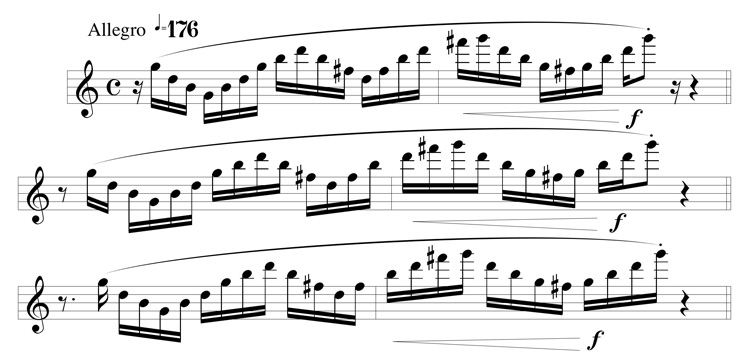PRACTICE RELIGIOUSLY OR PARISH, PART 4
by Leonard L. Garrison G. Displacing the beat. Walfrid Kujala reveals this secret in “Shifting the Beat for a Cleaner Technique.” Return to the arpeggios from Peter and the Wolf. Displace the beat as follows:

H. Changing articulations. We have already discussed practicing tongued passages slurred. The reverse also: practice slurred passages tongued. This can help you play more evenly. But why stop there? Substitute all sorts of articulations for the written ones. This enables you to see new shapes and relationships.
I. Memorizing. Your goal is to internalize the music, or as Sam Baron says, to become one with it. What better way than to memorize it, even if you don’t have to perform from memory? You become more confident and really feel like you know the music.
IX. Conclusion. Practicing may be as appetizing to you as going to the dentist, but some of us actually enjoy it (practicing, that is). Find a way to enjoy it. Be creative. Change your battle tactics. Repetition, yes, but not drudgery.
X. For further reading:
Baron, Samuel.“Practicing as a Way of Life,” Flute Talk (November 1984): 18-19.
Barry, Nancy H., and Victoria Mcarthur, “Teaching Practice Strategies in the Music Studio: A Survey of Applied Music Teachers,” Psychology of Music 22 (1994): 44-55.
Blaisdell, Frances. “How Do I Get to Carnegie Hall,” in The Flutist's Handbook: A Pedagogy Anthology (The National Flute Association, Inc., Santa Clarita, CA, 1998), 3-10.
Bruser, Madeline. The Art of Practicing: Making Music from the Heart. New York: Random House, 1997.
Clardy, Mary Karen. Flute Fundamentals: The Building Blocks of Technique (Valley Forge, PA: European American Music Corporation, 1993).
Debost, Michel. “Warming Up to Cool Down,” Flute Talk (July/August 1994): 4.
Floyd, Angeleita S. "Techniques for Practicing,” chapter IX of The Gilbert Legacy: Methods, Exercises and Techniques for the Flutist. Cedar Falls, IA: Winzer Press, 1990 (chapter IX).
Galway, James. “Thoughts on Playing the Flute,” Flute Talk (January 1989): 12-16.
Goodman, Marsha. “Rhythmic Distortion,” The Flutist Quarterly XIV/3 (Summer 1989): 70-73.
Hutchins, Timothy. “Perspective on Practicing,” Flute Talk (September 1994): 12-13.
Johnston, Philip. The Practice Revolution: Getting Great Results from the Six Days Between Lessons. Practice Spot Press, 2004.
Jones, Katherine Borst, and Christopher Weait. “Positive Preparation for Practice,” in The Flutist's Handbook: A Pedagogy Anthology (The National Flute Association, Inc., Santa Clarita, CA, 1998), 25-30.
Kemler, Katherine. "Practicing for Performance," Selected Flute Masterclasses (Malibu, CA: Windplayer Publications, 1998): 24-25.
Khaner, Jeffrey. “How to Practice,” in The Flutist's Handbook: A Pedagogy Anthology (The National Flute Association, Inc., Santa Clarita, CA, 1998), 31-34.
Kireilis, Ramon. “The Practice of Practicing,” The Instrumentalist (June 1976).
Klickstein, Gerald. The Musician's Way: A Guide to Practice, Performance, and Wellness. New York: Oxford University Press, 2009.
Krell, John. Kincaidiana: A Flute Player's Notebook, 2nd Edition. Santa Clarita, CA: 1997.
Kujala,Walfrid. “Shifting the Beat for a Cleaner Technique.” The Instrumentalist (April 1974).
Nyfenger, Thomas. Music and the Flute. Published by the author, Guilford, CT, 1986.
Wye, Trevor. Proper Flute Playing: A Companion to the Practice Books. London and Sevenoaks, Kent: Novello & Company Limited, 1988.
| 
